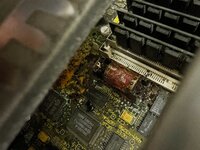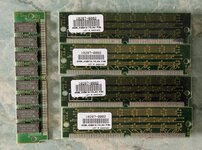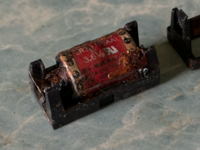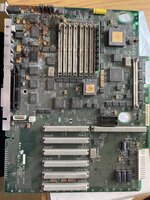Muirium
Member
What do we have here?

Very almost literally kicking around, behind the scenes at a local museum, the beige box on the floor turns out to be a Macintosh… II… fx! Ooh, let's take a looksie.
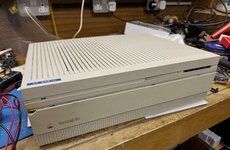
That's no way to treat a top of the line 1990 vintage Mac! Well, she's on the desktop now at least. Let's pop her open and see what we've got here.
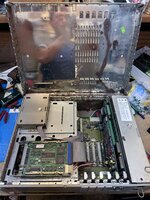
Only took one single screw to pop the lid open, quite a nice design. There's a pair of plastic levers you press in and up it goes. Also: that's the first Kensington lock I've ever seen actually installed. This was a corporate machine, going by its labels, back in its day.
Immediately obvious: one Quantum Fireball SCSI hardrive, floppy drive, two NuBus cards in the slots: they seem to both be graphics cards.
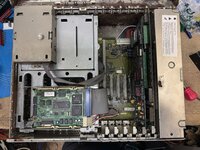
But this is where things turn from giddy discovery to a bit of a nightmare. What is all that corrosion? Let's take a look under the drive bracket.
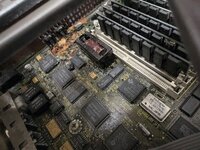
Oh boy! That PRAM battery is completely and catastrophically blown. In fact, when I tried to flip it out with a screwdriver, the holder came straight off with it! Eep!
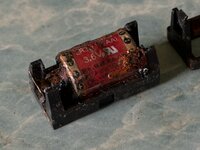
NOT the finest PRAM battery I've ever seen. I’m glad none of mine ever did this.
I think there's more going on than just a blown half-AA battery, however. The corrosion is much too extensive. It's not just focussed around that blown battery.

Rotten card slots!? What happened to you, IIfx? Which hell have you seen?
At this point, I reckoned powering up was quite out of the question. Obvs. As an SE/30 owner—currently mid-restoration, it's still Simasimac—I was interested in the salvage potential of this badly damaged IIfx though. I know its RAM is compatible, and its ROM is 32-bit clean. Let's have a look at those.
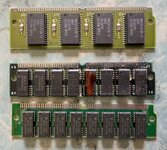
The top one is indeed a genuine IIfx ROM. Looks to be in fine fettle, as it was mounted a ways over from the kill zone. Phew!
Going by this helpful guide the codes on the RAM chips say that these are 4 megabyte and 1 megabyte SIMMs respectively. The IIfx was fully populated with 4 of each, for 20 megs total. My SE/30 has only 8x1 megabytes so the 4x4 are welcome. Well, if they still work. That one there—it was the closest to the PRAM battery—is however quite badly hit by whatever foul substance wrecked this Macintosh. Maybe beyond reuse…
Let's take a look at the hard drive. 80 megabytes of Quantum Fireball.
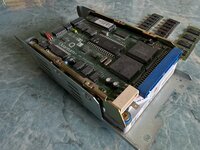
I put my BlueSCSI into initiator mode to power up this drive and clone its contents. I had just assembled the desktop BlueSCSI and used it to back up my SE/30's drive and another very similar 40 megabyte Quantum Fireball drive from the museum. Initiator mode worked perfectly on those two, which I did immediately before this, using the opened SE/30's power supply. The IIfx's drive whirred into action, but sounded pretty dry and nasty, and definitely louder than its little brother. Its amber LED blinked as it should, and it went up to full speed but the BlueSCSI couldn't get it to talk. A look at the log afterwards showed a lot of this as it tried several times:
So, the conclusion is that this IIfx is seriously effed! I might be able to salvage its precious 32-bit clean SE/30 compatible ROM, and mayyyybe the 16 megs of 4x4 SIMMs might work, if that damaged one isn't too corroded. Perhaps those graphics cards are in working order, I've no means to tell. But other than that, I think this one's a goner.
Such a strange way to meet you, queen of the 68030 age. It's like Sunset Boulevard.

Very almost literally kicking around, behind the scenes at a local museum, the beige box on the floor turns out to be a Macintosh… II… fx! Ooh, let's take a looksie.

That's no way to treat a top of the line 1990 vintage Mac! Well, she's on the desktop now at least. Let's pop her open and see what we've got here.

Only took one single screw to pop the lid open, quite a nice design. There's a pair of plastic levers you press in and up it goes. Also: that's the first Kensington lock I've ever seen actually installed. This was a corporate machine, going by its labels, back in its day.
Immediately obvious: one Quantum Fireball SCSI hardrive, floppy drive, two NuBus cards in the slots: they seem to both be graphics cards.

But this is where things turn from giddy discovery to a bit of a nightmare. What is all that corrosion? Let's take a look under the drive bracket.

Oh boy! That PRAM battery is completely and catastrophically blown. In fact, when I tried to flip it out with a screwdriver, the holder came straight off with it! Eep!

NOT the finest PRAM battery I've ever seen. I’m glad none of mine ever did this.
I think there's more going on than just a blown half-AA battery, however. The corrosion is much too extensive. It's not just focussed around that blown battery.

Rotten card slots!? What happened to you, IIfx? Which hell have you seen?
At this point, I reckoned powering up was quite out of the question. Obvs. As an SE/30 owner—currently mid-restoration, it's still Simasimac—I was interested in the salvage potential of this badly damaged IIfx though. I know its RAM is compatible, and its ROM is 32-bit clean. Let's have a look at those.

The top one is indeed a genuine IIfx ROM. Looks to be in fine fettle, as it was mounted a ways over from the kill zone. Phew!
Going by this helpful guide the codes on the RAM chips say that these are 4 megabyte and 1 megabyte SIMMs respectively. The IIfx was fully populated with 4 of each, for 20 megs total. My SE/30 has only 8x1 megabytes so the 4x4 are welcome. Well, if they still work. That one there—it was the closest to the PRAM battery—is however quite badly hit by whatever foul substance wrecked this Macintosh. Maybe beyond reuse…
Let's take a look at the hard drive. 80 megabytes of Quantum Fireball.

I put my BlueSCSI into initiator mode to power up this drive and clone its contents. I had just assembled the desktop BlueSCSI and used it to back up my SE/30's drive and another very similar 40 megabyte Quantum Fireball drive from the museum. Initiator mode worked perfectly on those two, which I did immediately before this, using the opened SE/30's power supply. The IIfx's drive whirred into action, but sounded pretty dry and nasty, and definitely louder than its little brother. Its amber LED blinked as it should, and it went up to full speed but the BlueSCSI couldn't get it to talk. A look at the log afterwards showed a lot of this as it tried several times:
Nothing from the drive then. That's a shame. I'd hoped a IIfx might have some rare professional software on it, being the Mac Pro of its day. But this drive is thoroughly uncooperative.* No response from SCSI ID 1
Executing BUS RESET after aborted command
RequestSense response: 0x00 0x00 0x00 0x00 0x00 0x00 0x00 0x00 0x00 0x00 0x00 0x00 0x00 0x00 0x00 0x00 0x00 0x00
* No response from SCSI ID 2
* No response from SCSI ID 3
* No response from SCSI ID 4
* No response from SCSI ID 5
* No response from SCSI ID 6
RequestSense response: 0x70 0x00 0x04 0x00 0x00 0x00 0x00 0x0A 0x00 0x00 0x00 0x00 0x9E 0x00 0x00 0x00 0x00 0x00
RequestSense response: 0x70 0x00 0x04 0x00 0x00 0x00 0x00 0x0A 0x00 0x00 0x00 0x00 0x9E 0x00 0x00 0x00 0x00 0x00
So, the conclusion is that this IIfx is seriously effed! I might be able to salvage its precious 32-bit clean SE/30 compatible ROM, and mayyyybe the 16 megs of 4x4 SIMMs might work, if that damaged one isn't too corroded. Perhaps those graphics cards are in working order, I've no means to tell. But other than that, I think this one's a goner.
Such a strange way to meet you, queen of the 68030 age. It's like Sunset Boulevard.
Attachments
Last edited:

